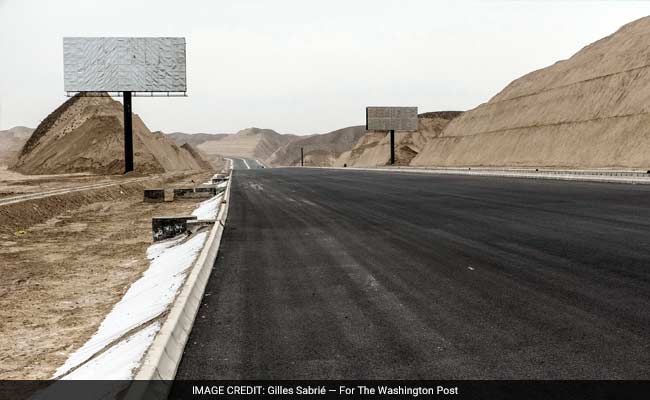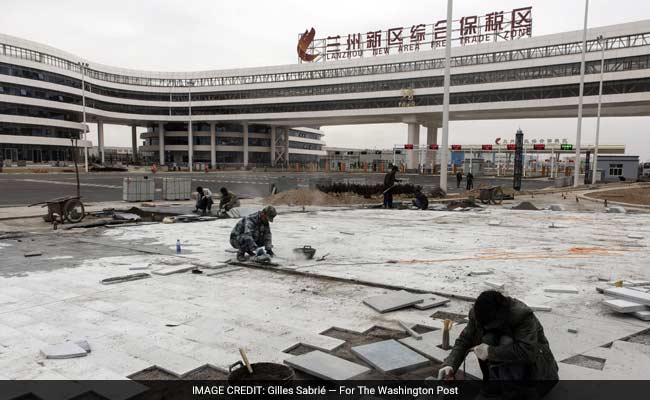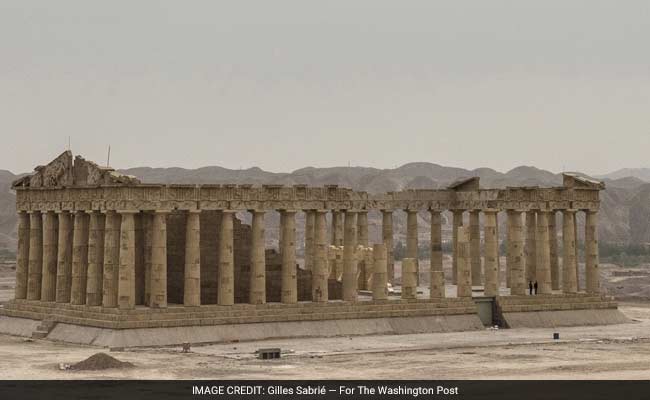
In Lanzhou New Area, locals ride one-wheel electric scooters past a row of nearly empty apartment buildings.
Lanzhou New Area, China:
This city is supposed to be the "diamond" on China's Silk Road Economic Belt -- a new metropolis carved out of the mountains in the country's arid northwest.
But it is shaping up to be fool's gold, a ghost city in the making.
Lanzhou New Area, in Gansu province, embodies China's twin dreams of catapulting its poorer western regions into the economic mainstream through an orgy of infrastructure spending and cementing its place at the heart of Asia through a revival of the ancient Silk Road.
Hundreds of hills on the dry, sandy Loess Plateau were flattened by bulldozers to create the 315-square-mile city. But today, cranes stand idle in planned industrial parks while newly built residential blocks loom empty. Streets are mostly deserted. Life-size replicas of the Parthenon and the Sphinx sit surrounded by wasteland, monuments to profligacy.
 The project epitomizes what is wrong with China's economic model, foreign experts say -- in particular, how debt is rising to alarming levels as the government tries to prop up a slowing economy with projects that make little or no commercial sense.
The project epitomizes what is wrong with China's economic model, foreign experts say -- in particular, how debt is rising to alarming levels as the government tries to prop up a slowing economy with projects that make little or no commercial sense.
"Where Gansu goes, China goes," said Rodney Jones, founder of Wigram Capital Advisors in Beijing. "You've had massive credit growth and investment in projects that don't generate an economic return.
"Now you're facing two shocks -- you've got to stop credit growing and deal with the bad loans, and you've also got to see how the economy expands once this credit boom is over."
China launched an ambitious "Go West" campaign at the turn of the millennium, aiming to narrow the income gap between the booming eastern seaboard and the remote west, essentially by building modern infrastructure and exploiting the west's natural resources.
The initiative got a huge boost as China launched a nationwide economic stimulus after the 2008 global financial crisis. And President Xi Jinping's plans to revitalize the Silk Road, the ancient desert trade route between East and West, have provided a further boost.
About $10 billion is being invested to clear Lanzhou New Area and build infrastructure that includes roads, railways and an expanded airport. Water is being diverted from a branch of the Yellow River and stored in three new reservoirs to create a city that a promotional video shows as awash with lakes and rivers.
A free-trade zone and logistics hub are meant to ensure that the city benefits from its location on a new Silk Road, while industrial parks dedicated to auto and equipment manufacturing, petrochemicals and traditional Chinese medicine are supposed to create the jobs that will sustain a city of 1 million by 2030.
 ---
---
On a recent trip organized by the provincial government, journalists were shown around a heavy-machinery plant run by the state-owned Lanzhou LS Group and the privately owned Scisky factory, which makes a water-based polymer resin. Scisky executives said they hoped to take advantage of local raw materials and export to Central Asia and Europe.
Xu Dawu, deputy Communist Party secretary for the New Area, says 150,000 people live here, along with 40,000 temporary construction workers -- but those numbers seem at odds with the largely empty vistas that visitors see.
The reality is that despite cheap land, tax holidays and large subsidies, the New Area has struggled to attract both investment and people. Yan Yuejin at E-house China R&D Institute in Shanghai looked at vacancy rates and concluded that the venture has been "very unsuccessful."
Even Xu admits to "a problem."
"Lanzhou is a very important town on the Silk Road, but it is sandwiched between two mountains with a river running through it," he said. To draw more industries from the south, he said, "we need to jump out of Lanzhou and seek a larger space."
If that doesn't work, he said in what sounded like a tacit admission of defeat, "we can at least develop modern agriculture here."
Chinese economists said Gansu is making basic economic missteps, investing in heavy industry at a time of global overcapacity and building infrastructure when it should be reducing its debt.
"This is just copying the old development model without taking local reality into consideration," said Ding Wenfeng, a professor of economics at the Chinese Academy of Governance, urging the government to apply an "emergency brake."
"Urbanization and modernization are processes that naturally take place," he said. "You can't force it to happen or have 1,000 places copy the same model."
Bao Cunkuan, an environmental science professor at Shanghai's Fudan University, agreed, arguing that the poorer northwestern provinces such as Gansu have typically survived by exporting people to richer parts of China, not by attracting people.
"People will vote with their feet," he said. "If the place is not good enough, nobody will come no matter how many houses you build. Where people go, the allocation of capital and resources should follow."
Gansu has a per capita annual income of just $4,000 and little trade with the outside world. Its growth was driven by metals and other minerals, as well as by real estate, but it is suffering the ill effects of China's slowdown and a global slump in commodity prices.
The province's attempt to spend its way to prosperity has only aggravated its problems. Last year, total credit expanded by about $50 billion, in an economy worth just $100 billion, Wigram Capital calculates. Despite the huge injection of credit, the economy shrank 1 percent in nominal terms, while the ratio of loans to gross domestic product expanded to 200 percent, up from under 90 percent in 2009.
 Andrew Polk at Medley Global Advisors in Beijing visited Lanzhou New Area recently and noted its "desolate" location. "You can just sense from being there it's not a commercially viable place," he said.
Andrew Polk at Medley Global Advisors in Beijing visited Lanzhou New Area recently and noted its "desolate" location. "You can just sense from being there it's not a commercially viable place," he said.
Yet the eagerness to support Xi's hallmark Silk Road initiative -- an economic belt running through Central Asia to Europe and a maritime Silk Road hugging Asia's southern coastline -- seems to trump economic sense.
"It's just another example of government priorities being at odds with each other," Polk said. "There is a desire to do the belt and road program, and there is also a desire to de-leverage. You can't do both at the same time, but we have seen time and time again in China which tends to win out."
© 2016 The Washington Post
But it is shaping up to be fool's gold, a ghost city in the making.
Lanzhou New Area, in Gansu province, embodies China's twin dreams of catapulting its poorer western regions into the economic mainstream through an orgy of infrastructure spending and cementing its place at the heart of Asia through a revival of the ancient Silk Road.
Hundreds of hills on the dry, sandy Loess Plateau were flattened by bulldozers to create the 315-square-mile city. But today, cranes stand idle in planned industrial parks while newly built residential blocks loom empty. Streets are mostly deserted. Life-size replicas of the Parthenon and the Sphinx sit surrounded by wasteland, monuments to profligacy.

The Lanzhou New Area ring road is being built through the Loess Mountains, which have been carved or had their tops leveled.
"Where Gansu goes, China goes," said Rodney Jones, founder of Wigram Capital Advisors in Beijing. "You've had massive credit growth and investment in projects that don't generate an economic return.
"Now you're facing two shocks -- you've got to stop credit growing and deal with the bad loans, and you've also got to see how the economy expands once this credit boom is over."
China launched an ambitious "Go West" campaign at the turn of the millennium, aiming to narrow the income gap between the booming eastern seaboard and the remote west, essentially by building modern infrastructure and exploiting the west's natural resources.
The initiative got a huge boost as China launched a nationwide economic stimulus after the 2008 global financial crisis. And President Xi Jinping's plans to revitalize the Silk Road, the ancient desert trade route between East and West, have provided a further boost.
About $10 billion is being invested to clear Lanzhou New Area and build infrastructure that includes roads, railways and an expanded airport. Water is being diverted from a branch of the Yellow River and stored in three new reservoirs to create a city that a promotional video shows as awash with lakes and rivers.
A free-trade zone and logistics hub are meant to ensure that the city benefits from its location on a new Silk Road, while industrial parks dedicated to auto and equipment manufacturing, petrochemicals and traditional Chinese medicine are supposed to create the jobs that will sustain a city of 1 million by 2030.

Construction workers help build near the gates of the new Free Trade Zone In Lanzhou New Area.
On a recent trip organized by the provincial government, journalists were shown around a heavy-machinery plant run by the state-owned Lanzhou LS Group and the privately owned Scisky factory, which makes a water-based polymer resin. Scisky executives said they hoped to take advantage of local raw materials and export to Central Asia and Europe.
Xu Dawu, deputy Communist Party secretary for the New Area, says 150,000 people live here, along with 40,000 temporary construction workers -- but those numbers seem at odds with the largely empty vistas that visitors see.
The reality is that despite cheap land, tax holidays and large subsidies, the New Area has struggled to attract both investment and people. Yan Yuejin at E-house China R&D Institute in Shanghai looked at vacancy rates and concluded that the venture has been "very unsuccessful."
Even Xu admits to "a problem."
"Lanzhou is a very important town on the Silk Road, but it is sandwiched between two mountains with a river running through it," he said. To draw more industries from the south, he said, "we need to jump out of Lanzhou and seek a larger space."
If that doesn't work, he said in what sounded like a tacit admission of defeat, "we can at least develop modern agriculture here."
Chinese economists said Gansu is making basic economic missteps, investing in heavy industry at a time of global overcapacity and building infrastructure when it should be reducing its debt.
"This is just copying the old development model without taking local reality into consideration," said Ding Wenfeng, a professor of economics at the Chinese Academy of Governance, urging the government to apply an "emergency brake."
"Urbanization and modernization are processes that naturally take place," he said. "You can't force it to happen or have 1,000 places copy the same model."
Bao Cunkuan, an environmental science professor at Shanghai's Fudan University, agreed, arguing that the poorer northwestern provinces such as Gansu have typically survived by exporting people to richer parts of China, not by attracting people.
"People will vote with their feet," he said. "If the place is not good enough, nobody will come no matter how many houses you build. Where people go, the allocation of capital and resources should follow."
Gansu has a per capita annual income of just $4,000 and little trade with the outside world. Its growth was driven by metals and other minerals, as well as by real estate, but it is suffering the ill effects of China's slowdown and a global slump in commodity prices.
The province's attempt to spend its way to prosperity has only aggravated its problems. Last year, total credit expanded by about $50 billion, in an economy worth just $100 billion, Wigram Capital calculates. Despite the huge injection of credit, the economy shrank 1 percent in nominal terms, while the ratio of loans to gross domestic product expanded to 200 percent, up from under 90 percent in 2009.

In Lanzhou New Area, a plane flies above full-scale replicas of the Parthenon and Great Sphinx of Giza, set in an area still under construction.
Yet the eagerness to support Xi's hallmark Silk Road initiative -- an economic belt running through Central Asia to Europe and a maritime Silk Road hugging Asia's southern coastline -- seems to trump economic sense.
"It's just another example of government priorities being at odds with each other," Polk said. "There is a desire to do the belt and road program, and there is also a desire to de-leverage. You can't do both at the same time, but we have seen time and time again in China which tends to win out."
© 2016 The Washington Post
Track Latest News Live on NDTV.com and get news updates from India and around the world

